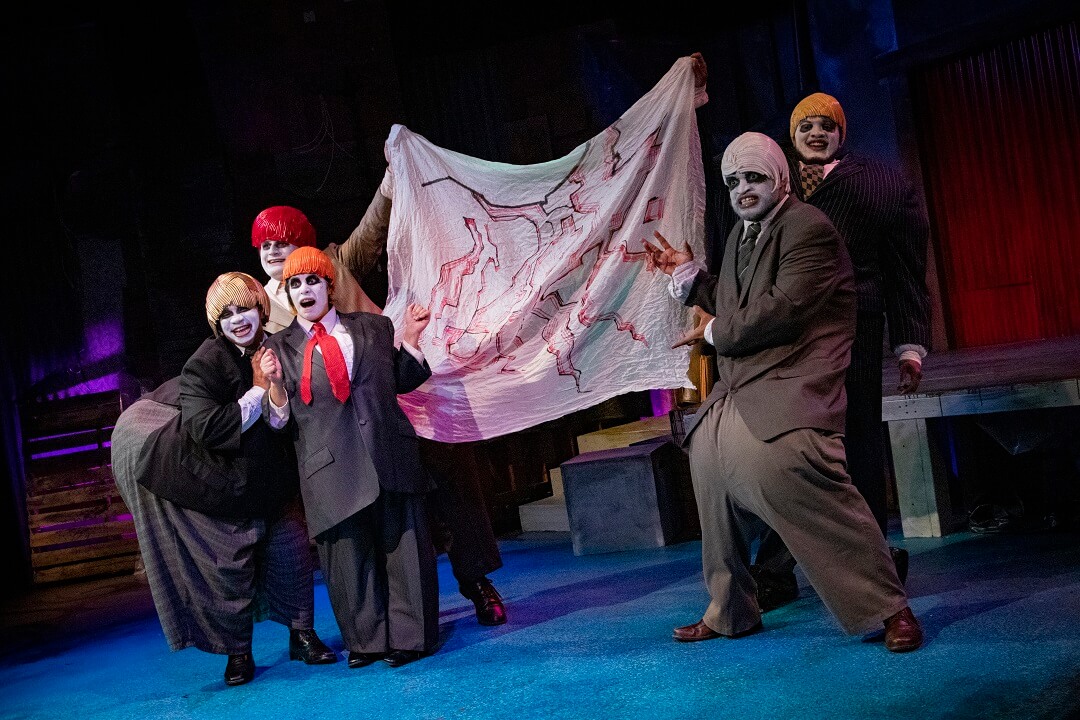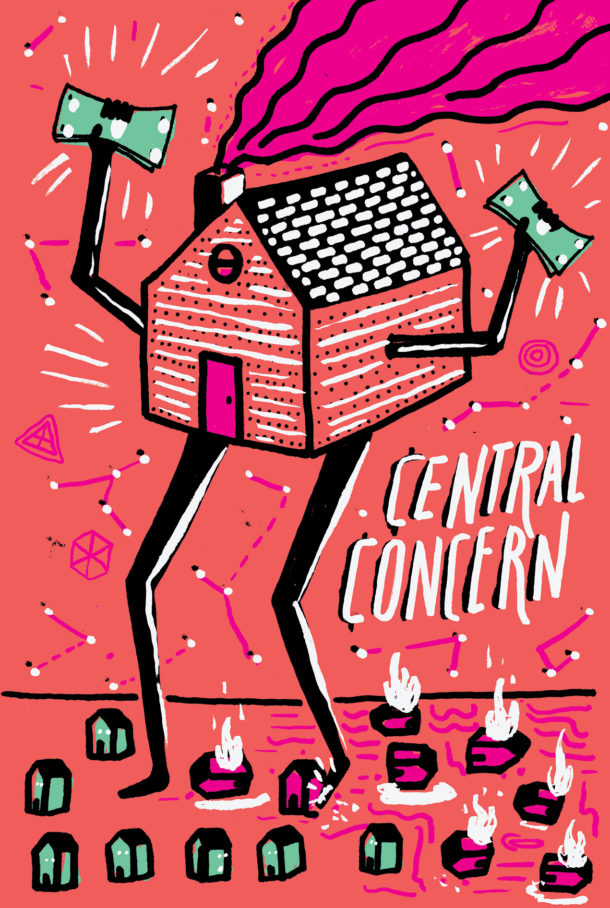Central Concern
The Creative Production Team Includes:
Raymond Bobgan – Producer
Beth Wood – Line Producer
Leigh Tennant – Stage Manager
Kitty Wen – Assistant Stage Manager
Aaron Benson – Scenic Designer
Carolyn Dickey – Costume Designer
KIX – Lighting Designer
Daniel McNamara – Composer / Musician
Jonathan Apriesnig – Musician
You, the Audience Member
The Central Concern experience is like… stepping onto the pages of a comic strip. Get ready to be entertained by a band of bouffons who break the barrier of the fourth wall—allowing (and encouraging) audience members to be active participants in their experience. Bouffon theatricality, which uses distorted body shapes, costumes, humor, and mockery to make fact-based comments about society as a whole, is a modern French theatre term re-invented in the early 1960s by Jacques Lecoq at his L’École Internationale de Théâtre Jacques Lecoq in Paris. Read more about bouffon theatricality here and here. The word “bouffon” comes from the Latin verb buffare: to puff, to fill the cheeks with air, to deform oneself, to swell in order to provoke laughter. While the audience laughs at your typical clown, a bouffon laughs at (and is constantly fascinated by) the audience. And that means: you are part of the cast! Your presence is what will make Central Concern come alive.
POST-SHOW FACILITATED CONVERSATIONS
Every performance of Central Concern will be followed by a post-show discussion. Join us for these important conversations after the performance.


ABOUT CONCEIVEr & Director Pandora Robertson
 Pandora Robertson is Executive Artistic Director at Ohio City Theatre Project (OCTP). OCTP credits include the January 2016 OCTP/Cleveland Public Theatre (CPT) co-production of Incendiaries (director/creator), the May 2014 premiere of Free Radical and The Night Sketchbook (director/creator), and co-production of Code Breakers (director/creator) with Theater Ninjas’ (now Maelstrom Collaborative Arts) May 2016 Broken Codes. Other credits include Mamaí Theatre Company’s production of Woman and Scarecrow (director) (Cleveland Critics Circle Award “Superior Achievement” for direction and play), Theater Ninjas’ (now Maelstrom Collaborative Arts) production of Melissa James Gibson’s [sic] (director), Cleveland Shakespeare Festival’s 2013 The Two Gentlemen of Verona (director), and Tree of Grace (Playwright, Director) for Baldwin Wallace University’s Department of Theatre and Dance. She was a CPT 2011/2012 Joan Yellen Horvitz Director Fellow. CPT credits include Meantime Anthopocene (director, creator) and 13 Most American Dreams (director, creator). Cleveland Play House credits include Galileo (choreographer), The Emperor’s Groovy New Clothes (choreographer), and Ferdinand the Bull (choreographer). Pandora has worked extensively in Northeast Ohio as a director, actor, choreographer, and dancer, with Great Lakes Theater, Dobama Theatre, Porthouse Theatre, convergence-continuum, and Ensemble Theatre. She danced for seven years with Ohio Ballet under the direction of Heinz Poll. She holds an MA in Theater Arts from Case Western Reserve University. Pandora is a 2018 recipient of an Ohio Arts Council Individual Excellence Award for playwriting, a 2016 Community Partnership for Arts and Culture Creative Workforce Fellow, and was featured in Cleveland Scene‘s 2017 People issue.
Pandora Robertson is Executive Artistic Director at Ohio City Theatre Project (OCTP). OCTP credits include the January 2016 OCTP/Cleveland Public Theatre (CPT) co-production of Incendiaries (director/creator), the May 2014 premiere of Free Radical and The Night Sketchbook (director/creator), and co-production of Code Breakers (director/creator) with Theater Ninjas’ (now Maelstrom Collaborative Arts) May 2016 Broken Codes. Other credits include Mamaí Theatre Company’s production of Woman and Scarecrow (director) (Cleveland Critics Circle Award “Superior Achievement” for direction and play), Theater Ninjas’ (now Maelstrom Collaborative Arts) production of Melissa James Gibson’s [sic] (director), Cleveland Shakespeare Festival’s 2013 The Two Gentlemen of Verona (director), and Tree of Grace (Playwright, Director) for Baldwin Wallace University’s Department of Theatre and Dance. She was a CPT 2011/2012 Joan Yellen Horvitz Director Fellow. CPT credits include Meantime Anthopocene (director, creator) and 13 Most American Dreams (director, creator). Cleveland Play House credits include Galileo (choreographer), The Emperor’s Groovy New Clothes (choreographer), and Ferdinand the Bull (choreographer). Pandora has worked extensively in Northeast Ohio as a director, actor, choreographer, and dancer, with Great Lakes Theater, Dobama Theatre, Porthouse Theatre, convergence-continuum, and Ensemble Theatre. She danced for seven years with Ohio Ballet under the direction of Heinz Poll. She holds an MA in Theater Arts from Case Western Reserve University. Pandora is a 2018 recipient of an Ohio Arts Council Individual Excellence Award for playwriting, a 2016 Community Partnership for Arts and Culture Creative Workforce Fellow, and was featured in Cleveland Scene‘s 2017 People issue.
About Ohio City Theatre Project (OCTP)
 Ohio City Theatre Project is committed to pursuing excellence and building community through creative innovation, mentoring, and civic involvement. OCTP strives to create visceral theatrical experiences that are not just thought about, but are deeply felt. OCTP takes on important contemporary issues that are hard to grapple with and provides opportunities for transformative exchange where we can converse and feel through these issues collectively with our community. www.ohiocitytheatreproject.com
Ohio City Theatre Project is committed to pursuing excellence and building community through creative innovation, mentoring, and civic involvement. OCTP strives to create visceral theatrical experiences that are not just thought about, but are deeply felt. OCTP takes on important contemporary issues that are hard to grapple with and provides opportunities for transformative exchange where we can converse and feel through these issues collectively with our community. www.ohiocitytheatreproject.com
“Imagine if Bertolt Brecht and Kurt Weill’s political satire Three Penny Opera told the story of how the real estate industry impacted segregation in Cleveland. Then picture this musical play living inside the delightfully grotesque world of a Hieronymus Bosch painting. Central Concern aims to be edgy, funny, and entertaining.”
-Pandora Robertson, Conceiver/Director of Central Concern
A co-production with Ohio City Theatre Project, Central Concern is inspired by the madcap boom, bust cycles, and Cleveland’s real estate industry, taking us from Moses Cleaveland and the Connecticut Land Company to the present day “great inversion.” Through a playful exploration of history, this world premiere production finds parallels and influences shaping our current political culture and leadership.


A Message from Pandora
In early 2016 after we finished Incendiaries, a co-production with CPT based on the race riots that tore through Cleveland’s Hough neighborhood in the late 1960s, it felt like the area of Cleveland history in relationship to segregation, and social justice, had momentum and it needed to continue. I just didn’t want to leave it alone. Incendiaries is about a particular 6 days of history… well, what was the history before that 6 days? It didn’t happen in a vacuum.
Originally, I was going to explore the history of Cleveland’s Central neighborhood (which is where the name Central Concern came from), or the idea of gentrification. And then I read Richard Rothstein’s essay “The Making of Ferguson,” and I thought: this has to have happened in Cleveland. I wanted to create a piece about institutionalized racism… how do you make that theatrical without lecturing people? Institutionalized racism is the water we swim in. So I focused on the real estate industry in Cleveland.
Central Concern lives in the dramatic territory of bouffon theatricality, which is very suited to tackle large social issues. Bouffon uses distorted body shapes, costumes, humor, and mockery to make fact-based comments about society as a whole.
Social justice really speaks to my heart. It’s a way for me, and I truly believe for many artists, to get outside of our own bubble and look at yourself and our community from the field. Exploring issues of social justice has this ability to expand your emotional life, and your spiritual life—and not without its vulnerability and pain, of course. Instead of your heart being as big as your fist, it can become as big as a lake.
Pandora Robertson
Conceiver/Director of Central Concern


An introduction to bouffon theatricality

“At the heart of the bouffon is mockery pushed to the point of parody.” -Jacques Lecoq
Central Concern lives in the dramatic territory of bouffon, which uses distorted body shapes, costumes, humor, and mockery to make fact-based comments about society as a whole. Bouffon is a modern French theatre term re-invented in the early 1960s by Jacques Lecoq at his L’École Internationale de Théâtre Jacques Lecoq in Paris.

“Bouffons are not human, they are grotesque, immortal shapeshifters who live somewhere between humans and the gods. Nothing is sacred to them; they are endlessly entertained and fascinated by human fallibility. And as such, they live in a state of ecstasy in mocking.
The dramatic territory of bouffons and the grotesque is well-suited to take on big social themes and issues… In looking at the real estate industry’s boom and bust wealth creation cycle, we could say that it creates so much it destroys, and destroys so much it creates. Central Concern‘s band of bouffons disguise themselves as real estate men and take us through the madness and absurdity in this history.”
-Pandora Robertson, Conceiver/Director of Central Concern
To discover more about bouffon theatricality, click here for an in-depth explanation from Jacques LeCoq’s book Le Théâtre Du Geste: Mimes et Acteurs, translated by David Bradby.
Art you can feel
Like Central Concern, these works aim to provoke visceral sensations
“I’ve always been interested in art that was very visceral, like the work of sculptor Louise Bourgeois, or painter Hieronymus Bosch, who is one of the inspirations for Central Concern. How does a visual like that work? You look at it and go ‘Ughhhhh.’ I think putting that kind of very visceral, feel-it-in-your-body feeling together with social justice, which I think are the most pressing issues of our time, has the potential to be very powerful.
-Pandora Robertson, Conceiver/Director of Central Concern


Segregation of American cities
Richard Rothstein’s “The Making of Ferguson” was a Spark of INspiration behind Central Concern
“That government, not private prejudice, was responsible for segregating greater St. Louis was once widely recognized. In 1974, a federal appeals court concluded, ‘Segregated housing in the St. Louis metropolitan area was… in large measure the result of deliberate racial discrimination in the housing market by the real estate industry and by agencies of the federal, state, and local governments.’ The Department of Justice stipulated to this truth but took no action in response. In 1980, a federal court ordered the state, county, and city governments to devise plans to integrate schools by integrating housing. Public officials ignored the order, devising only a voluntary busing plan to integrate schools, but not housing.
Although policies to impose segregation are no longer explicit, their effect endures. When we blame private prejudice and snobbishness for contemporary segregation, we not only whitewash history but avoid considering whether new policies might instead promote an integrated community.”
Click here or on the image to read the article that helped inspire the creation of Central Concern.
Brush up on your real estate terminology
Blockbusting
Blockbusting is a method used by U.S. real estate agents of introducing African American homeowners into previously all-white neighborhoods and then using aggressive, racist scare tactics to panic the white property owners into selling their homes well below market value… and then selling those homes at a substantial markup to African Americans, whose alternate housing options were so grim, many buyers had no choice but to pay the inflated costs. Click here to read more.
Redlining
 Redlining is a discriminatory practice by which lenders refuse loans to borrowers living in specific neighborhoods. Lenders would literally draw a red line around geographic regions on a map—regions typically with a high concentration of people of color—and then deny loans to people living in those areas. Click here to read about the origin of redlining, spearheaded in the 1930s by the Federal Housing Administration (FHA) and the Home Owners’ Loan Corporation (HOLC), and click here or on the image to discover the reverberating effects of redlining in Cleveland today.
Redlining is a discriminatory practice by which lenders refuse loans to borrowers living in specific neighborhoods. Lenders would literally draw a red line around geographic regions on a map—regions typically with a high concentration of people of color—and then deny loans to people living in those areas. Click here to read about the origin of redlining, spearheaded in the 1930s by the Federal Housing Administration (FHA) and the Home Owners’ Loan Corporation (HOLC), and click here or on the image to discover the reverberating effects of redlining in Cleveland today.
Subprime loans and foreclosures
When the recession hit in the late 2000s, Cleveland’s Slavic Village was at the epicenter of the foreclosure crisis, thanks to a rise in subprime loans. Lenders would intentionally offer mortgages with high interest rates to people with low income or poor credit history, with the understanding that the borrower would likely default on the loan.
“Until the mid-1990s banks only lent to borrowers with more or less sterling credit. Now, with a quick spreadsheet calculation, lenders can find a loan to suit almost any customer—at the right interest rate, and often with outsize fees. Even if a few borrowers fail to keep up, banks will still make money since they can repossess and resell those properties.” -Alyssa Katz, Mother Jones
Subprime loans were responsible for 84% of the foreclosure lawsuits filed in Cuyahoga County from 2005-2006, according to a study by the Center on Urban Poverty and Community Development at Case Western Reserve University. Click here to read more on cleveland.com.


CENTRAL CONCERN is made possible through the generous support of
and individual donors


 WANT TO LEARN MORE ABOUT CLEVELAND’S HISTORY? VISIT…
WANT TO LEARN MORE ABOUT CLEVELAND’S HISTORY? VISIT…
Undesign the Redline – AN interactive exhibit
Enterprise Community Partners, Cleveland Neighborhood Progress, and Detroit Shoreway Community Development Organization and Cudell Improvement Inc., are hosting Undesign the Redline, an interactive exhibit exploring the history of race, class, and U.S. housing policy, and how this legacy of inequity and exclusion continues to shape our communities. The exhibit seeks to spark public discourse on how discriminatory federal policies from the 1930’s continue to impact Cleveland neighborhoods today.
The Undesign the Redline exhibit will be at 6016 Lorain Ave., Cleveland, OH, 44102 from Monday, April 15th, 2019 to Monday, July 1st, 2019. The exhibit is free & open to the public.
Click here to learn more–or click here to sign up for a private tour!










